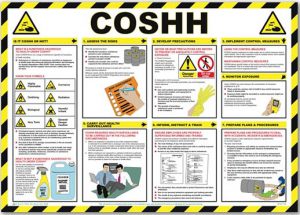COSHH is a U.K. legislation requiring employers to take active measures to control substances that are hazardous to the health of employees. A key element of adhering to COSHH guidelines is to discover the health hazards arising from exposure and handling. Then you must decide on how to prevent or reduce potential health risks arising from these chemicals. To identify risks and decide on precautions, you will need to conduct a COSHH assessment.
Evaluating Risks
Risks are not just limited to substances labelled as or clearly identified as hazardous. Health hazards can arise from chemicals, products containing chemicals, fumes, dusts, vapours, mists, nanotechnology, gases, asphyxiating gases and biological agents.
Every business is different so it’s important not to copy a risk assessment from another business. You need to think through the hazards and measures required for your specific workplace. The HSE provide risk assessment examples and templates for a number of different business that you can use as a guide.
Conducting a COSHH Risk Assessment
To conduct a COSHH risk assessment, take a walk around your workplace and carefully consider any potential chemical hazards. Consider the activities, processes and substances used and whether they could present a health hazard for employees. Ask yourself the following questions as you walk around the workplace.
1. Are there areas where employees could be exposed to substances hazardous to their health?
Try to identify processes that exude dusts, fumes, vapours, mists or gases. Pay particular attention to areas where employees may encounter skin contact with potentially hazardous liquids, pastes and dusts. Can you identify any substances with workplace exposure limits (WELs)?
2. In what way are the identified substances harmful to health?
Check manufacturers’ instructions or material safety data sheets for detail on any potential hazards relating to specific substances. Some hazardous substances will arise from processes and therefore have no safety data sheet.
3. What specific tasks lead to exposure?
Consider the various tasks and jobs conducted in the workplace. Could any of these tasks create hazardous substances? For example, hazardous fumes can arise from welding or soldering, chemical mists can be produced from metalworking fluids, harmful dusts can arise from stone works and noxious gases can arise from farming processes. If you are unaware as to whether a specific activity exudes any harmful fumes, conduct some online research or consult a health and safety expert.
4. Are there any areas of concern to note from the Accident Log Book?
Often the accident log book can provide insight into hazards you may not have previously considered. Examples can include burns from leaked or spilled liquids or liquid spatters, nausea or dizziness after using solvents, burning or stinging eyes after use or exposure to a substance or inhalation of fumes.
Risk Assessment Follow Up
Conducting a risk assessment is only effective if you and your employees actively act on the measures detailed. You must follow through with any required action resulting from the risk assessment. It is also important to regularly re-assess chemical risks in the workplace in order to meet COSHH compliance. Here at Safety Storage Systems UK, we understand the health and safety requirements when storing hazardous chemicals. To learn more about chemical safety, contact one of our experts today or check out our previous articles.
